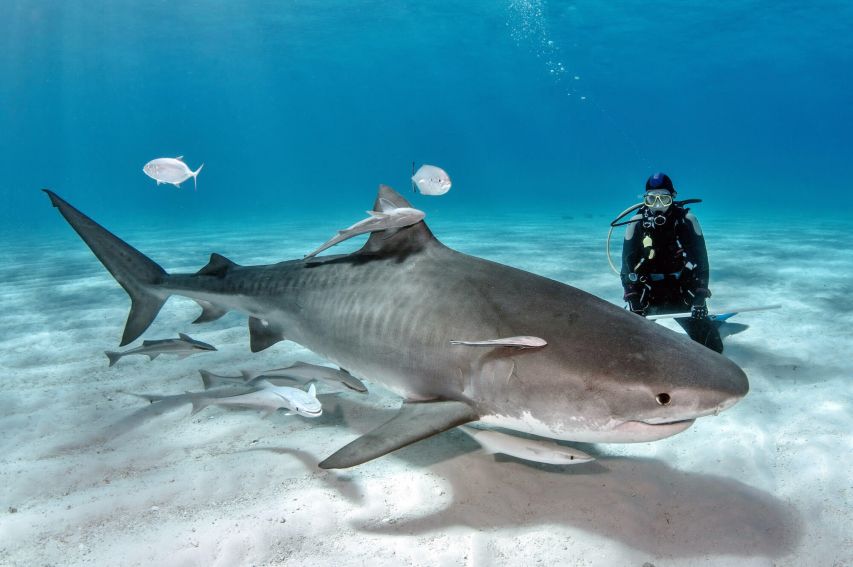Protecting the Dolores and Building Lasting Connections
Introduction: Why TripOutside Joined the Protect the Dolores Campaign As part of TripOutside’s ..
Read more
As I dove beneath the surface of Cabo Pulmo’s turquoise waters on my birthday in 2024, surrounded by schools of fish and gliding alongside graceful sharks, I had a realization: these animals are worth far more alive than dead. Cabo Pulmo, once almost devoid of life due to overfishing, has rebounded into one of the richest marine sanctuaries in the world. Now, instead of nets and spears, it’s cameras and curious divers that fuel the local economy. The area’s transformation shows us that if we protect marine life, the oceans—and local communities—can thrive together.

For years, sharks have been killed by the millions for products like shark fin, which is a delicacy in some cultures. But what if the real financial treasure lay not in death, but in the chance to see these animals in the wild? Let’s break it down: selling a shark’s fin or meat provides a one-time payout, but keeping that shark alive brings consistent revenue through tourism.
A single shark can draw thousands of dollars in revenue from divers, photographers, and marine enthusiasts. These visitors don’t just pay for a boat ride or guide; they spend on hotels, meals, transport, and local goods, creating a ripple effect that fuels entire communities. In places like the Bahamas, shark tourism has become a multi-million-dollar industry, bringing in more revenue than shark finning ever could.
The financial potential extends beyond sharks. Manta rays, whale sharks, sea turtles—each of these species has a dedicated following, and people are willing to travel the world just for the chance to encounter them. For coastal communities, marine tourism offers a sustainable path to economic growth, especially as traditional fishing becomes less viable due to depleted stocks and environmental regulations.
Every sighting of these majestic creatures boosts the economy in ways that no quick sale could match. For example, a manta ray swimming free in a marine reserve draws in divers season after season, while a dead one has a fixed, far lower value.
Taking sharks, rays, or turtles out of the ocean does more than hurt tourism—it disrupts the entire marine ecosystem. Sharks, as apex predators, play a vital role in maintaining the balance of marine life. Without them, the health of coral reefs, fish populations, and even seabed vegetation suffers. An ocean without its natural inhabitants becomes a barren place, with fewer fish, degraded coral, and an unbalanced food chain.
And as the ecosystems deteriorate, so too does the tourism appeal. For every species lost or habitat damaged, we lose a little of the ocean’s magic—and its economic potential.
Cabo Pulmo’s revival serves as a powerful example of how protecting marine life benefits both nature and people. Local fishermen, who once emptied the seas, became its fiercest protectors after seeing the positive impact of establishing the marine park. Now, the reef is flourishing, boasting some of the highest levels of biodiversity in the world.
Similar success stories can be found around the globe. In Australia’s Great Barrier Reef, New Zealand’s Poor Knights Islands, and the Galapagos, establishing protected areas has not only restored marine life but also brought new income streams to surrounding communities. These places prove that conserving marine life can pay off—literally.
Alive is worth more than dead. This simple truth is both an ecological and economic imperative. Every dollar spent to see a living shark or manta ray fuels a sustainable industry, one that encourages people to protect, rather than exploit, our oceans. As more places embrace marine protected areas and sustainable tourism, we get closer to a future where local communities and ocean ecosystems can thrive together.
So, the next time you book a dive or visit a marine sanctuary, remember—you’re part of a movement that keeps the ocean alive, for all of us.
Of course, diving and tourism have their own impacts. Everything we do has an impact! We’ve talked about following Leave No Trace practices while Scuba Diving and sustainable, regenerative tourism to ensure that we don’t end up loving our outdoor places to death. However, not killing the golden goose as an economic driver for the locals is the message that I want to discuss in this post today. What do you think? Leave a comment below.